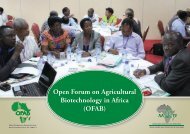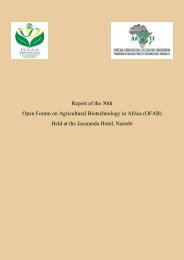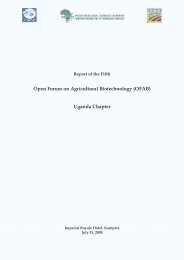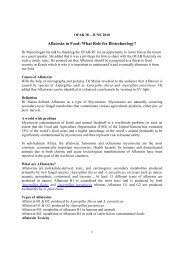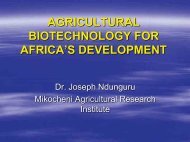Annex 1 List of Participants - OFAB
Annex 1 List of Participants - OFAB
Annex 1 List of Participants - OFAB
You also want an ePaper? Increase the reach of your titles
YUMPU automatically turns print PDFs into web optimized ePapers that Google loves.
A: Dr. Higgins said that it would take 5-8 years in testing the different ecological<br />
zones in Africa for the demonstration to reach farmers.<br />
Q: Dr. Dorrington Ogoyi, Senior Lecturer, Department <strong>of</strong> Biochemistry, University<br />
<strong>of</strong> Nairobi, wondered why the main cowpea pest in Africa Maruca Vitrata was not<br />
initially the target in the development <strong>of</strong> Bt cowpea. He also wanted to know if the<br />
Bt gene Cry 1AB being used was effective against Maruca.<br />
A: Dr. Higgins said that the target Helicoverpa armigera was available in the lab and<br />
that is why it was used instead <strong>of</strong> Maruca which is not in Australia. Dr. Bokanga<br />
added that it is possible to do the tests in Africa and that discussions are on going.<br />
However, lack <strong>of</strong> regulatory structures and hindering regulations has been the main<br />
stumbling block.<br />
Q: Ms. Rachael Shibalira from the Attorney General’s Chambers, sought to know<br />
why public acceptance is a problem in Australia yet they had accepted Bt cotton.<br />
A: Dr. Higgins explained that public acceptance is the biggest challenge <strong>of</strong> all. He<br />
urged stakeholders in Africa not to underrate it. Canola was approved by regulators<br />
but the public had mixed reactions where 50% still had concerns about GM food<br />
crops. He underscored the importance <strong>of</strong> involving consumers and farmer<br />
organizations in decision making about GM crops.<br />
Q: Mr. Edward Kateiya <strong>of</strong> Kenya National Federation <strong>of</strong> Agricultural Producers<br />
(KENFAP) was concerned about the farmers facing high cost <strong>of</strong> production, research<br />
taking too long, risk <strong>of</strong> resistance management and low acceptability by the public.<br />
He wondered why the researcher should use a lot <strong>of</strong> resources to do something that<br />
could be rejected.<br />
A: Dr. Higgins said that researchers should not take positions on the biotechnology<br />
debate but work diligently to make the world a better place. He said scientists must<br />
take risks to succeed in doing their work. Referring to the book titled “Feeding the 10<br />
billion people” the presenter was categorical that there is need for R&D in order to<br />
cope with the growing demand for food, feed and fibre.<br />
Dr. Karembu also emphasized the importance <strong>of</strong> taking risks in research to improve<br />
quality <strong>of</strong> seeds in order to boost food production.<br />
Q: Dr. Santie de Villiers <strong>of</strong> ICRISAT, wanted to know if the observed resistance had<br />
been confirmed in the green houses and field trials since all the testing had been<br />
done in the lab.<br />
A: Dr. Higgins said that tests had only been done in the green house and that no<br />
field tests had been done. However, he was optimistic that they will do well in the<br />
fields since there was plenty <strong>of</strong> information about biotechnology.<br />
9



